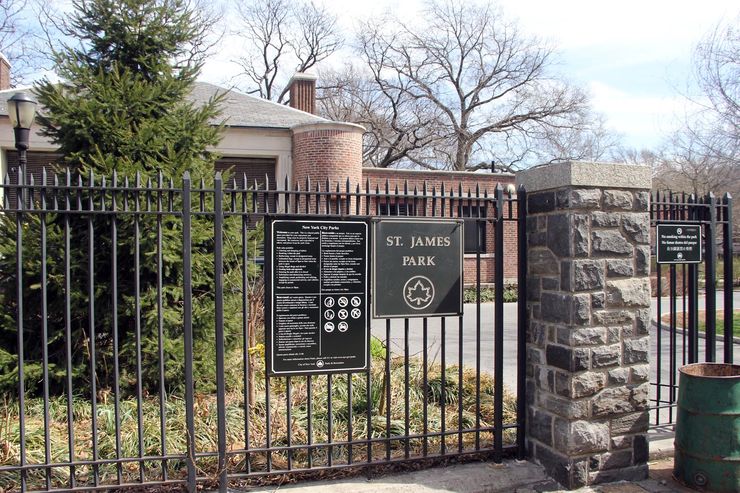
St. James Park, in the Fordham section of the Bronx, between Jerome
and Creston Avenues and East 191st and 193rd Streets, a few hundred feet
north of the intersection of Grand Concourse and Fordham Road [MAP]. This is the park entrance at
Morris Avenue and 191st Street, April 15, 2015. St. James Park was created
by the City about 1900 and named after a
nearby church. According to a NYC
Parks Department press of June 3, 1935:
This park is eleven and one half acres in area and was completely replanned and reconstructed during the past four months. A Central Mall, with wide bench line paths facing a centre turf panel, bisects the area taking the place of the former dusty extension of 132nd Street. South of the Mall is a large open lawn encircled by a promenade for park visitors. The northern section is devoted principally to recreation activities. Twelve new tennis courts have been provided and a completely equipped children's playground occupies the space along Jerome Avenue. The work this spring has involved the construction of paths, the grading and top-soiling of the lawn areas and the setting out of 192 trees and 5865 shrubs.Although the press release does not credit the CWA, PWA, WPA, or any other New Deal agency for labor, design, or funding, the Parks had just received 11,000 laborers from the newly-formed WPA, and had 33,000 relief workers by March of that year, so there can be little doubt that this project was accomplished through federal funds and labor (see commmentary).
An April 9, 1937 press release announces the construction of:
...a new recreation building in St. James Park at Jerome Avenue and 191st Street, The Bronx. The opening of this building marks the completion of the redesign of this eleven and one-half acre park, the reconstruction of which began in 1935. The building is constructed of brick with a slate roof and provides men's and women's comfort station facilities, a mother's room and a large play room for indoor games during inclement weather.The same press release goes on to add:
The twelve earth surfaced tennis courts, which were formerly in the park, have been resurfaced, eight with clay and four with asphalt, thereby providing longer periods of play during the early spring and late fall when alternating periods of freeze and thaw ordinarily render clay courts unusable. During sub-freezing temperatures the asphalt courts are also flooded for ice-skating. One hundred and eighty-nine new concrete benches have been installed, four thousand new trees and shrubs planted and seven new concrete drinking fountains installed, all fitting into a comprehensive landscape scheme.This press release, like the first one, fails to give credit for the design, funding, and labor; see the same commentary. Like the Oval Park recreation center or, for that matter, any other NYC park building dating from Great Depression that I have seen, this one has no cornerstone or any indication of who designed and built it, which is probably the best indication that it was a New Deal project.
|
The New Deal in
NYC 1932-1943 |
Frank da Cruz |
fdc@columbia.edu
|